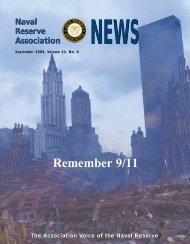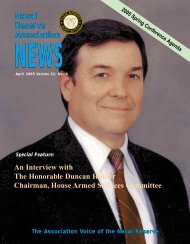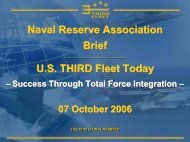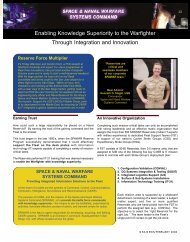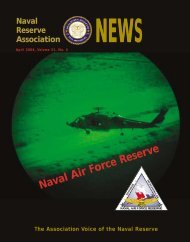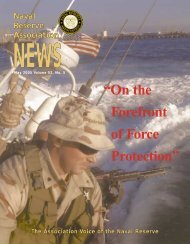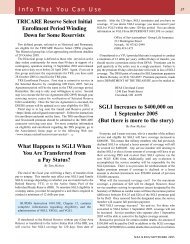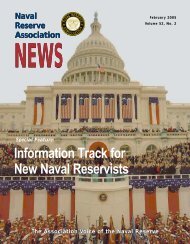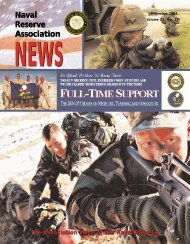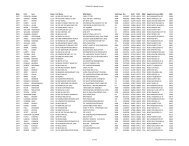âOn the Forefront of Force Protectionâ
âOn the Forefront of Force Protectionâ
âOn the Forefront of Force Protectionâ
Create successful ePaper yourself
Turn your PDF publications into a flip-book with our unique Google optimized e-Paper software.
13“On <strong>the</strong> <strong>Forefront</strong> <strong>of</strong><strong>Force</strong> Protection”By JO1 Martha D. Kennedy-Lindley, USNRMARFPCOM Public Affairs Office“There is no better reserve homethan with a NCW unit. You canIBU boats with Statue <strong>of</strong> Liberty in<strong>the</strong> background.“We train on <strong>the</strong>Members <strong>of</strong> thisbeaches, in <strong>the</strong> woodscommunity havecontribute to real-world action.and in <strong>the</strong> water,” saidnoticed significantCAPT Donald McMackin,changes since <strong>the</strong>You may have more work thanCommanding Officer <strong>of</strong>USS Cole bombingNaval Coastal Warfare reserve center units, three-day in October 2000.Squadron 33 and a member“We went from a<strong>of</strong> <strong>the</strong> NCW community drill weekends, and hours <strong>of</strong> <strong>of</strong>fdutysurveillance group towork; but <strong>the</strong> satisfaction force protectionsince 1992. “We are abouta real antiterrorism/one-third through ourpredeployment training,mission,” said Masterand rewards are worth it.”and things are going well.”Chief BoatswainmateHis squadron staff,Edward F. Gallagher,Master Chief Boatswainmate Edward F. GallagherInshore Boat Unit 16 andMember MIUW 205, Charleston, SC a member <strong>of</strong> MIUWMobile Inshore UnderseaWarfare Unit 102 willdeploy this spring to <strong>the</strong> 5th Fleet area <strong>of</strong>205 in Charleston,SC.With <strong>the</strong> Global War on Terrorism andresponsibility.increased mission tasking combined with <strong>the</strong>NCW units, in different forms, have been around community’s evolving role into an Expeditionarysince World War II. Previously, <strong>the</strong> units were Antiterrorism/<strong>Force</strong> Protection <strong>Force</strong>, Navalcomprised solely <strong>of</strong> Reservists and exclusivelysupplied <strong>the</strong> manpower for <strong>the</strong> Inshore Boat Unitsand Mobile Inshore Undersea Warfare Units. NCW hasplayed a major role in every conflict since <strong>the</strong> 1940s.Coastal Warfare is taking a leading role in real-worldoperations while helping with <strong>the</strong> establishment<strong>of</strong> fully active duty units through active/reserveintegration.NRA NEWS/MAY 2005
14The job: worldwide waterside force protectionLT Eileen Kane, <strong>the</strong> vehiclemaintenance <strong>of</strong>ficer for MIUW205, recently left active duty andaffiliated with <strong>the</strong> Navy’s Reserve. Shewas a nuclear <strong>of</strong>ficer on active duty. “Theclosest I came to NCW and its missionwas when I served as a collateral dutyforce protection <strong>of</strong>ficer as an ensign.”The mission <strong>of</strong> NCW is to provideforce protection for strategic shippingand naval vessels operating in <strong>the</strong>inshore areas, anchorages, harbors, andharbor facilities through surface andsubsurface surveillance. In addition,units provide support to deployedSpecial Operations <strong>Force</strong>s, counterdrugoperations, maritime prepositioningforces, and law enforcement <strong>of</strong>ficials.Two Naval Coastal Warfare Groups oversee all aspects <strong>of</strong> <strong>the</strong>NCW mission – Naval Coastal Warfare Group One (NCWGRU1)in San Diego, CA, and Naval Coastal Warfare Group Two (NCW-GRU2) in Portsmouth, VA. The group level commanders areresponsible for centralized planning, training, and <strong>the</strong> equipping<strong>of</strong> coastal warfare assets. The groups exercise administrative andoperational control over NCWassets assigned within <strong>the</strong> unifiedand/or allied command structure.The groups transitioned from reserveto active duty in February 2004.Reporting directly to <strong>the</strong>groups are eight NCW squadrons(NCWRON) responsible for twentyMobile Inshore Undersea WarfareUnits (MIUW), sixteen Inshore BoatUnits (IBU), and four MobileSecurity (MSRON) Squadrons.Naval Coastal WarfareSquadrons – As support staffs,squadrons provide operational andadministrative oversight to <strong>the</strong>irMIUWs and IBUs. A squadronmay be called to deploy with <strong>the</strong>ir units but <strong>of</strong>ten remain statesidewhile individual units deploy. Squadrons are equipped withMobile Ashore Support Terminals (MAST). They may alsosupport U.S. Coast Guard Port Security Units by adding commandand control capability; harbor management; intelligence analysis;and inshore, armed transportable port security boats providing quickreactingsurveillance, interdiction support, and point defense.LT Eileen Kane, vehicle maintenance <strong>of</strong>ficer forMIUW 205, Charleston, SC, and Damage ControlmanSecond Class Paul Ahrens complete vehiclemaintenance check. (U.S. Navy photo by JournalistFirst Class Martha D. Kennedy-Lindley)NRA NEWS/MAY 2005
15Electronics Technician FirstClass David C. Thompson, MIUW205, Charleston, SC, performsroutine maintenance on <strong>the</strong>unit’s equipment during a drillweekend. (U.S. Navy photo byJournalist First Class Martha D.Kennedy-Lindley)Mobile Inshore UnderseaWarfare Units – MIUWUs,capable <strong>of</strong> self-containedcoastal warfare support, addsurveillance, command andcontrol, and reconnaissancecapabilities to <strong>the</strong> NCW forcepackage. MIUWUs arecommissioned, deployableoperating units equippedwith AN/TSQ-108A(V3)or (V4) Radar SonarSurveillance Center (RSSC)systems and associatedsupport equipment. Theymay be asked to providecommand, control,communication, andsurveillance support t<strong>of</strong>orce protection <strong>of</strong>ficersor a harbor defensecommander. In addition,<strong>the</strong> commanding <strong>of</strong>ficer<strong>of</strong> <strong>the</strong> MIUW may serve asa seaward security <strong>of</strong>ficerduring expeditionary warfareoperations with tacticalcontrol <strong>of</strong> assigned coastal warfare operations to ensureuninterrupted flow <strong>of</strong> strategic cargo and units to <strong>the</strong> combatantcommander.Inshore Boat Units – IBUs bring armed small boats to providequick reacting interdiction support for coastal warfare. IBUs aredeployable units equipped with 27- or 34-foot patrol crafts andassociated support equipment. They routinely operate with o<strong>the</strong>rNCW assets to provide an enhanced package for conductingsmall craft security and support for naval operations in <strong>the</strong> littoralenvironment.Members <strong>of</strong> MIUW 101, Everett, WA, on a patrol trainingmission. (U.S. Navy photo by Journalist First Class RalphRadford)Master Chief Gallagher has completed two Middle Eastdeployments since 2000 and calls <strong>the</strong> MIUWU’s missions “realworld.”LT Kane, a 1999 Naval Academy graduate, has not yetdeployed but is ready to go when <strong>the</strong> unit mobilizes. “We have<strong>the</strong> skills and training plus great leadership starting with <strong>the</strong>LPOs right up <strong>the</strong> chain.”Weekend and annual training is used for continual practice andrefining <strong>of</strong> skills that are put to work during deployment. NCWunits have access to <strong>the</strong>ir equipment at <strong>the</strong>ir drill site and allmembers are responsible for maintenance and equipment upkeep.This provides <strong>the</strong> opportunity for personnel to have hands-ontraining each drill weekend. This ongoing training prepares <strong>the</strong>units to meet short-notice deployment requests. Unit membersappreciate <strong>the</strong> active, hands-on training in an environment awayfrom a desk.When deployed, <strong>the</strong> unit goes to <strong>the</strong>ir assigned location andsets up camp. Living conditions can range from hotel rooms, tobarracks, to tents; but <strong>the</strong>y are always near <strong>the</strong> harbor. The unitsmay be required to provide <strong>the</strong>ir own security and force protectionin addition to regular mission requirements, and <strong>the</strong>ir trainingreflects <strong>the</strong> added responsibility.NCWRON 33 members watch as <strong>the</strong> proper hand position for9mm pistol usage is demonstrated. Prior to deploying, <strong>the</strong>yreceive training on 9mm pistol, M-16A3 service rifle, and12-gauge shotgun. ( U.S. Navy photo by Photographer’s Mate2nd Class Ron Trevino)Mobile Security Squadrons – The squadrons are anexclusively active duty component <strong>of</strong> Naval Coastal Warfare.The first squadron was commissioned in January 2003. MobileSecurity Detachments provide fleet and component commanderswith a rapidly deployable active duty force ready to performphysical security to high value assets, ships, and aircraft on <strong>the</strong>water, land, or in <strong>the</strong> air.The reserve NCW squadrons and associated units are located inCalifornia, Texas, Washington, Oregon, Missouri, Rhode Island,New York, Connecticut, Virginia, Maryland, New Jersey, SouthCarolina, Florida, and Georgia.The active NCW Squadrons and Mobile Security Squadronsand <strong>the</strong>ir associated units are located in Portsmouth, VA; SanDiego, CA; and Guam.NRA NEWS/MAY 2005
16NCW: currently reserve driven“Every person in uniform today is a minuteman.Every one <strong>of</strong> us needs to respond quickly to crisis.Whe<strong>the</strong>r it’s here at home or whe<strong>the</strong>r it is abroad,”said VADM John Cotton, Chief <strong>of</strong> Navy Reserve, in aFebruary interview with <strong>the</strong> Naval Media Center. Hepointed to NCW as an example. “We have smallboats. We can do New York Harbor security,Charleston security, Jacksonville, San Diego, Seattle,whatever it might be. We can do <strong>the</strong> home game andtrain to deploy and go overseas to <strong>the</strong> Gulf like <strong>the</strong>NCW Squadron in Kuwait right now.”New 34-foot high-speed crafts in New York Harbor. (OfficialU.S. Navy photo)Reservists were <strong>the</strong> backbone <strong>of</strong> Naval Coastal Warfare for oversixty years. Currently, <strong>the</strong>re are 390 drilling reserve <strong>of</strong>ficers; 4,100enlisted; 380 active duty <strong>of</strong>ficers; and 3,837 enlisted personnel in NCWunits worldwide. There is a 5 to 95 percent mix <strong>of</strong> full-time supportto Selected Reserve personnel. Of <strong>the</strong> 4,490 Reservists currently onactive duty, approximately 660 are deployed with NCW units.All NCW reserve units are Priority 1-A (PRI 1-A) for manningpurposes, and all assignments are guaranteed for two years.Presently, cross-assigned personnel are guaranteed a minimum<strong>of</strong> one trip to <strong>the</strong> gaining command per quarter; and flexiblescheduling is possible. Personnel are required to perform annualtraining with NCW.“We have aviators, submariners, civil engineers, and intelligence<strong>of</strong>ficers in our units. NCW Squadrons (NCWRONs) <strong>of</strong>ferleadership opportunities at all levels. You can be a truecommodore at <strong>the</strong> O-6 level,” McMackin said.Units are open to all unrestricted line <strong>of</strong>ficers and mostenlisted rates.CAPT Robert L. Greene, Commanding Officer, NCWSquadron 26, said, “You can’t expect to be a weekend warrior ina NCW unit. Every SELRES must have a deliverable everyweekend. They must have a sense <strong>of</strong> accountability.”For Storekeeper Second Class Tabitha Nuner, IBU 16, “Thepredeployment training is great, and each week is more intense.”She joined <strong>the</strong> Navy’s Reserve three years ago through <strong>the</strong>nonprior service program. “I chose to go to <strong>the</strong> IBU. I wantedto go out in <strong>the</strong> field. I wanted to be active.” Her upcomingdeployment will be her first, but she is not <strong>the</strong> first in her familyto deploy to <strong>the</strong> AOR. Her son serves in <strong>the</strong> Marine Corps andreceived a Purple Heart for injuries sustained in Iraq.LT Kane enjoys her assignment – “There is always somethingdifferent to do. We are an operational unit.” She also finds <strong>the</strong>uniforms a visual change. “I wore coveralls on active duty, now Iam in a green unit.”New TYCOM: meeting <strong>the</strong> needIn October 2004, a new Type Commander (TYCOM) wascommissioned under Commander Fleet <strong>Force</strong>s Command.Commander, Maritime <strong>Force</strong> Protection Command(MARFPCOM) headquartered at <strong>the</strong> Little Creek NavalAmphibious Base, Norfolk, VA, is responsible for <strong>the</strong> training,equipping, and administration <strong>of</strong> active and reserve ExpeditionaryAntiterrorism/<strong>Force</strong> Protection <strong>Force</strong>s.“This is <strong>the</strong> first time <strong>the</strong> Navy has stood up a single entity t<strong>of</strong>ocus solely on <strong>the</strong> Navy’s Expeditionary Antiterrorism/<strong>Force</strong>Protection <strong>Force</strong>,” said CAPT Mark Kosnik, CommanderMaritime <strong>Force</strong> Protection Command.MARFPCOM aligned <strong>the</strong> existing components: Naval CoastalWarfare, Mobile Security <strong>Force</strong>s, Explosive Ordnance Disposal,and Expeditionary Mobile Diving and Salvage into one unifiedcommand with <strong>the</strong> capability to be at <strong>the</strong> forefront <strong>of</strong> AT/FPmissions.“The Navy, like o<strong>the</strong>r branches <strong>of</strong> <strong>the</strong> armed forces, has lookedat <strong>the</strong> impact <strong>of</strong> <strong>the</strong> increasing terrorist threats on operationalforces; and because <strong>of</strong> that increased threat, we have put morefocus on force protection,” said CAPT Kosnik.One <strong>of</strong> <strong>the</strong> changes after MARFPCOM’s stand-up was <strong>the</strong>consolidation <strong>of</strong> previous training methods into one standardizedsystem. The new system creates unity and provides consistentperformance and capability. Master Chief Gallagher points outthat his MIUW’s gear is upgraded and modernized, includingweapons and an extensive training program.NRA NEWS/MAY 2005
17The increased focus on force protection and NCW’s role hastaken a toll on <strong>the</strong> community as well. The Navy Reserve<strong>Force</strong> provided NCW units for more and more tasking resultingin many Reservists being mobilized for <strong>the</strong> maximum allowed 24months since <strong>the</strong> GWOT began in 2001.The benchmark was established by Secretary <strong>of</strong> DefenseDonald Rumsfield. He announced a new policy that envisions amore balanced military force with active and reserve componentssharing in a one-year in six-year mobilization.“The merger <strong>of</strong> <strong>the</strong> active and reserve components <strong>of</strong> NCW,integration with <strong>the</strong> active duty force, and creation <strong>of</strong> Maritime<strong>Force</strong> Protection Command has given our Reservists not only aleading role in <strong>the</strong> Global War on Terrorism but also <strong>the</strong> resourcesto accomplish <strong>the</strong> mission,” said CAPT John Kittler, DeputyCommander <strong>of</strong> Naval Coastal Warfare Group TWO.The active Navy, spurred by MARFPCOM, is quickly respondingto this increased demand on a predominantly reserve force. Twoactive component NCW squadrons are standing up and areexpected to be fully operational in FY-06/07. The new squadrons,one from each coast, are replacing reserve component forces andwill relieve <strong>the</strong> burden <strong>of</strong> mobilization on existing forces.“Presently, <strong>the</strong> Reservists provide a capability not availablein <strong>the</strong> active Navy,” said CAPT Kosnik. More experiencedReservists are supplying much <strong>of</strong> <strong>the</strong> training for <strong>the</strong> activecomponents. “Their execution <strong>of</strong> <strong>the</strong> mission is <strong>the</strong> model for <strong>the</strong>stand-up <strong>of</strong> <strong>the</strong> new active units,” said CAPT Kosnik.Member <strong>of</strong> IBU 27, Charleston, SC, qualifies with M-16 priorto deployment. (U.S. Navy Photo by Chief ElectronicsTechnician (SS/SC) Ronald V.A. Marcell)In addition to his deployments to <strong>the</strong> Persian Gulf, MasterChief Gallagher was also involved in exercises and training inPortugal and at <strong>the</strong> Navy’s former bombing range in Puerto Rico.He has helped with weapons and range training for <strong>the</strong> newMobile Security Detachments. “The training went well. Therewas no problem.” With <strong>the</strong> stand-up <strong>of</strong> eight new Mobile SecuritySK2 Mary Frescas, MIUWU-102, hits center ring whilequalifying with <strong>the</strong> 9mm Beretta pistol on range 111 atCamp Pendleton. (U.S. Navy photo by Photographer’s Mate2nd Class Ron Trevino)Detachments, two active duty Naval Coastal Warfare Squadrons,four active Inshore Boat Units, and two active MIUWs, <strong>the</strong>Reservists are sharing <strong>the</strong>ir wisdom and expertise by training<strong>the</strong>ir active duty counterparts.Reserve Senior Chief QuartermasterJohn F. Mulvey, a 9-year veteran <strong>of</strong> <strong>the</strong>NCW community, is currently servingon <strong>the</strong> staff at MARFPCOM. “After Ireturned from mobilization to Kuwait,MARFPCOM was looking for subjectmatter experts for <strong>the</strong> training department.They <strong>of</strong>fered me a job, and I have beenhere for over a year.”VADM Cotton said that <strong>the</strong> Navy’sactive/reserve integration has been asuccess and that <strong>the</strong> Reservists are providingoperational support worldwide.“We’re much more integrated at everysingle command so now <strong>the</strong> command canturn to <strong>the</strong>ir reserve counterpart and say,‘Listen, I need some people for a couple<strong>of</strong> weeks to go help with whatever itmight be’ . . . and <strong>the</strong> Reservists surge to meet that . . . and doa great job. That’s really what active/reserve integrationmeans . . . ,” VADM Cotton said.“The active/reserve integration in NCW is going alongseamlessly. It is a beautiful merge,” Senior Chief Mulvey said.Naval Coastal Warfare is finding <strong>the</strong> balance in <strong>the</strong>active/reserve integration. Active duty components are standingup to relieve <strong>the</strong> pressure from <strong>the</strong> reserve force, while drawingon <strong>the</strong> many years <strong>of</strong> experience and training resident in <strong>the</strong>reserve components.NRA NEWS/MAY 2005
18Coast Guard: part <strong>of</strong> <strong>the</strong> teamNCW components <strong>of</strong>ten include Coast Guard members asfully integrated members <strong>of</strong> port security teams. Thereare 15 USCG members assigned to NCW Squadron25 currently deployed to Kuwait. “They are just like any o<strong>the</strong>rpart <strong>of</strong> <strong>the</strong> staff,” said CAPT Edward McAnaney, CommandingOfficer <strong>of</strong> NCW Squadron 25. “Everyone here is a pr<strong>of</strong>essional.”Port Security Specialist Second Class Arturo Hernandez,USCGR, is a member <strong>of</strong> NCW Squadron 25. “Every day issomething different. I work with port security and standdifferent security watches.”Mission: real-world“This is a very challenging mission and <strong>the</strong> reserveforces are doing an impressive job,” said CAPT Kosnikafter a February visit to NCW Squadron 25 in Kuwait.“Those young Sailors are doing great work. No matterwhat <strong>the</strong> challenge, <strong>the</strong>y find a way to meet it with success.”CAPT Kosnik pointed to CAPT McAnaney and his forces asan example <strong>of</strong> <strong>the</strong> impressive job being done in <strong>the</strong>atre.“Commodore McAnaney has overall command <strong>of</strong> <strong>the</strong> security <strong>of</strong><strong>the</strong> Port <strong>of</strong> Ash Shuaybah, Kuwait. He runs an impressive andefficient organization.”CAPT McAnaney leads over 350 Navy and Coast GuardReservists in port security operations. NCW Squadron 25,Yorktown, VA, is deployed with MIUW Unit 204 and IBU 24from Fort Dix, NJ, as well as IBU 22 from Groton, CT.“Things are going really well. We’ve been here over six monthsworking 24 hours a day, seven days a week,” said McAnaney.“No days <strong>of</strong>f, including <strong>the</strong> holidays. There is always somethingto do. We have periods <strong>of</strong> increased activity, and all our missionsare armed.”Petty Officer Hernandez, a law enforcement <strong>of</strong>ficer insou<strong>the</strong>rn Georgia, has been in <strong>the</strong> Coast Guard just over a yearand was recently promoted to second class. “I talked to o<strong>the</strong>rport security specialists and learned <strong>the</strong> ups and downs, <strong>the</strong> insideand outside <strong>of</strong> <strong>the</strong> rate and <strong>the</strong> mission before joining.” He seesmany benefits to going overseas which include working with<strong>the</strong> Navy and Army as well as foreign military. “You learn so muchthat way,” said Petty Officer Hernandez.CAPT McMackin will also have Coast Guard membersdeploying with his squadron this spring. “One Coast Guardsmanis active and received permission to deploy with us, and <strong>the</strong> restare Reservists,” he said.“We try to draw <strong>the</strong> best from both <strong>the</strong> Navy and <strong>the</strong> CoastGuard,” said McMackin. The USCG port security specialists are<strong>the</strong> experts in security boardings, environmental issues, searchand rescue. The Navy has just recently started specializing in<strong>the</strong>se areas. The two services are training, learning, andaccomplishing missions toge<strong>the</strong>r.Chief Port Security Specialist David Larkin will serve as <strong>the</strong><strong>Force</strong> Protection Chief for NCW Squadron 33 on <strong>the</strong>ir upcomingdeployment. “This is a fantastic experience.” This will be his firstdeployment to <strong>the</strong> Middle East and his second Title 10 recall. “Iwas expecting this recall. The first time I was recalled was aboutfifteen minutes after <strong>the</strong> second World Trade Center building fell,”said Larkin. He spent his first recall in <strong>the</strong> Pacific Northwest.Left: LCDR Scott Tetrick, IBU 27, mans <strong>the</strong> radio during underwaylive fire exercises <strong>of</strong>f <strong>the</strong> coast <strong>of</strong> Crete. (U.S. Navy Photo byChief Electronics Technician (SS/SC) Ronald V.A. Marcell)Port security watchstander with M-60 close at hand.(Official U.S. Navy photo)NRA NEWS/MAY 2005
19CAPT McAnaney spent two years with a MIUW in <strong>the</strong>1990s and <strong>the</strong>n five years with <strong>the</strong> squadron. He became <strong>the</strong>commanding <strong>of</strong>ficer in 2002. “There is a much greater demand forforce protection missions around <strong>the</strong> globe,” said CAPTMcAnaney.Speaking on behalf <strong>of</strong> his squadron he said, “Every one <strong>of</strong> us isproud to be here serving his/her country and doing our best with<strong>the</strong> good tools we have available to make sure that our missionis finished safely and that we all go home to our families soon.”CAPT Greene also feels <strong>the</strong> pressure to bring his squadronhome safely. While <strong>the</strong>y have not received <strong>the</strong>ir deployment date,<strong>the</strong>y are in <strong>the</strong> rotation schedule. “Our vision is that 100 percent<strong>of</strong> our deployed squadron personnel return safely home to <strong>the</strong>irloved ones with an unparalleled sense <strong>of</strong> accomplishment andpride to be remembered for a lifetime.”It will be CAPT McMackin’s squadron that relievesCAPT McAnaney’s squadron. As his squadron continues withintensive training, McMackin says, “Folks in NCW are reallyoutstanding. I will be going forward with ten people I have servedwith before. It is a continuum <strong>of</strong> experience.” He expects to bedeployed for a year.The Naval Coastal Warfare community is fast-paced andleading edge. Directly responsible for <strong>the</strong> Navy’s overseas forceprotection, this community is in <strong>the</strong> spotlight.A mobile security detachment 25-foot safe boat during acombat tactical turn. (Official U.S. Navy photo)On watch with a 50-caliber machine gun nearby. (Official U.S.Navy photo)WANT TO MAKE A MEANINGFUL CONTRIBUTIONTO THE DEFENSE OF OUR COUNTRY?LOOKING FOR A MORE ACTION-PACKED RESERVE EXPERIENCE?IF SO, THERE IS A PLACE FOR YOU IN THEMARITIME FORCE PROTECTION COMMAND“There is no better reserve home than witha NCW unit. You can contribute to real-worldaction. You may have more work than reservecenter units, three-day drill weekends, and hours<strong>of</strong> <strong>of</strong>f-duty work; but <strong>the</strong> satisfaction and rewardsare worth it.” – BMCM Gallagher“NCW is <strong>the</strong> premier place to be in <strong>the</strong> Navy’sReserve. You have an opportunity to serve <strong>the</strong> countryand be involved, deeply involved, in operationalissues.” – CAPT McAnaneyThe Navy is recognizing <strong>the</strong> growing responsibility for this primarily reserve community and responding with <strong>the</strong> manpowerand equipment needed. Units are located throughout <strong>the</strong> country and are listed in <strong>the</strong> organization chart on page 14.For more information on how you can join this elite group <strong>of</strong> pr<strong>of</strong>essionals, contact:CWO2 Debra Neubecker, NCWGRU1, (619) 437-9434, CWO3 Rod Smith, NCWGRU2, (757) 396-0602, Or, contact your local reserve activityNRA NEWS/MAY 2005



